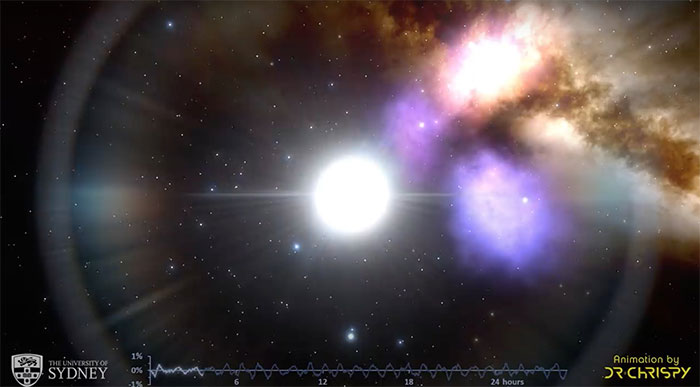For the first time discovered the 'heartbeat' of the mysterious star
According to a study published in Nature this week, new data from the space telescope for NASA's Explorers (TESS) program reveals the exact model from inside of dozens of nearby stars.
'Previously, we have found too many confusing records to properly understand these wavering stars' - CBS News quoted the study's lead author - Professor Tim Bedding from the University of Sydney. ' It's a mess like hearing a cat walking on the piano '.

The Delta Scuti star is named after a star in the constellation Scutum, which is 1.5 to 2.5 times the mass of the Sun. Although researchers are aware that these stars may have "heartbeats", they have not previously been able to detect any pattern of beats.
After looking at thousands of stars, the team found 60 stars, which are located about 60 to 1,400 light-years from Earth, with regular high-frequency pulses, essentially like a beating heartbeat. . One of the stars studied, beta Pictoris , is only 60 light-years from Earth and is visible to the naked eye in Australia.
'Accurate data from TESS has allowed us to cut down on noise and be able to detect structures, listen much better than an excellent piano track , ' Professor Bedding said.
These elusive beats are due to the energy accumulated and released inside the stars, usually in two main categories. The scientists noted that some of the stars they studied were surprisingly close to others.
Observation results show that this star class is very young and tends to hang around in loose links. They have no idea about the rules of "social spacing" - Professor Bedding said.
The researchers said that exploring seismic planets on the planet is like looking inside a star and looking at the structure inside them. The discovery could help explain the inner workings of billions of stars across the universe.
- Detecting the star system 'heartbeat' super strange in the universe
- The mysterious age of the mysterious star
- Found another star that mysteriously dimmed
- For the first time, a star has been discovered in a star
- The scientists were skeptical of discovering Star Death
- Mysterious giant star on the surface of the Earth
- The first time discovered the water drop star
- The mysterious planet causes the orbiting star to age
- Revealed the mysterious 'star-shaped map', nearly 5km long in Hawaii
- Mysterious waves of radio waves outside the universe
- The neutron star collision is 520 million light-years from Earth
- The mysterious 'ghost star' threatens the Earth
 Van Allen's belt and evidence that the Apollo 11 mission to the Moon was myth
Van Allen's belt and evidence that the Apollo 11 mission to the Moon was myth The levels of civilization in the universe (Kardashev scale)
The levels of civilization in the universe (Kardashev scale) Today Mars, the sun and the Earth are aligned
Today Mars, the sun and the Earth are aligned The Amazon owner announced a secret plan to build a space base for thousands of people
The Amazon owner announced a secret plan to build a space base for thousands of people NASA discovers two stars colliding so violently that they created gold
NASA discovers two stars colliding so violently that they created gold  James Webb Telescope Discovers Massive Supercluster Hidden Deep in the Milky Way
James Webb Telescope Discovers Massive Supercluster Hidden Deep in the Milky Way  'Time travel' 13.5 billion years, NASA telescope finds 4 cosmic ancestors
'Time travel' 13.5 billion years, NASA telescope finds 4 cosmic ancestors  Why there are no stars in American photos of the Moon
Why there are no stars in American photos of the Moon  Aliens control the fastest moving stars in the galaxy?
Aliens control the fastest moving stars in the galaxy?  First 'hybrid' star and planet object revealed outside the Milky Way
First 'hybrid' star and planet object revealed outside the Milky Way 